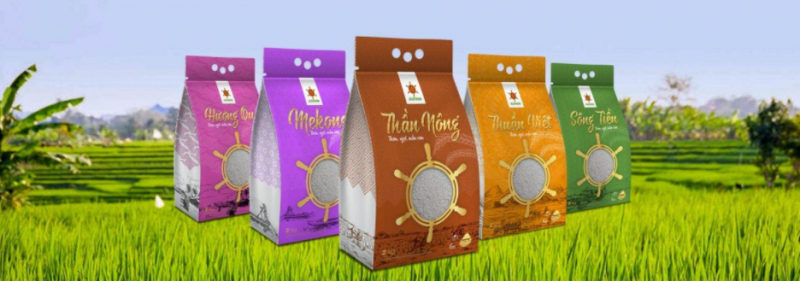A few months ago a very talented young chef told me that cooking rice is one of the hardest things to do in a restaurant. There’s the quantity involved for serving a lot of guests, and the lack of the right pot and even heat. He baked rice in a shallow “hotel” pan and used jasmine with a 1:2 ratio of rice to water because he liked it softer for the French dishes he prepared. His rice was nice but I didn’t have the heart to tell him that I didn’t like his rice as much as I enjoyed every other component of the meal. The thing is, rice lovers are particular.
A Hmong farmer once told me that he mixed long-grain and short-grain to get a satisfying chewy-firm texture. One of my mom’s friends buys fresh-crop rice and ages it because fresh-crop is too mushy for her. Then there are cuisine specific preferences too: long-grain vs. medium vs. short vs. super long basmati. Regular rice or sticky rice? White, brown, or partially milled beige rice. Rice culture is complex and elastic.
Rice was the first thing I thought that I mastered. My mom taught me to prepare rice the way my dad liked it – firm with a certain toothsome texture. If I made it too dry or too wet, I apologized to the family at the dinner table. There was always another batch of rice to be made.
I learned to make rice in a cheap National brand rice cooker, using my finger to measure the water. Each day I made the same amount – measured with a brown melamine coffee cup, so it was no sweat. I gauged the water level with the same finger each time and we only had one rice cooker. I learned to be consistent. What I didn’t learn that there was a difference between rice cooked in a pot and a rice cooker.
After moving away from home, I cooked in small rental apartment kitchens for years. Counter space was high-value real estate and I began making rice in a heavy-bottomed, one-quart saucepan. I bought it at Macy’s and my rice was good but not perfect. The grains cooked unevenly – softer on the bottom than the top.
When I was writing Into the Vietnamese Kitchen, I got very frustrated and accused my mom of not teaching me how to make rice right. That’s when she told me that I was doing it all wrong for a pot. Seriously? What the heck did you train me to do when I was a kid?
“You have to stir,” she said. “How do you expect the rice to cook evenly if you let it sit in just one spot in the pot? I learned to cook rice in a clay pot and used rice straw.”
My eyes must have been rolling when Mom threw out those little details and challenge. Then she explained how to cook a pot of rice on the stove. I’ve taught my husband Rory how to do it and he now says his rice is consistently better than mine. We actually fight a little as to who gets to make the rice. He likes this All-Clad pot.
Here are some tips and revelations for you to consider:
What kind of rice to cook and where to buy it?

We can debate for a long time. I like my grains to retain their individuality but not be dry. The cooked rice should be soft but not mushy. It should taste clean and sweet and have a wonderful fragrance. It should be great on its own (I sprinkle a little fish sauce on my rice or work in some Maggi and Bretel butter) but also be ready to play nice with other dishes.
If you’re like the Hmong farmer who likes rice that sticks to your ribs, use a medium-grain rice, such as what’s enjoyed in Japan and Korea. If dry rice is preferred, basmati may be your ticket. For Vietnamese and other kinds of Southeast Asian and East Asian cuisines, basmati is a little too dry for most uses.
My everyday rice used to be Thai jasmine long-grain rice but now eat a lot of partially milled “beige” medium-grain rice. Jasmine sold at Asian markets is lovely and fragrant. The turnover is high so you get fresher stuff. Similarly, for the beige rice, I go to a Chinese market. Regular supermarkets and health food stores have okay to good rice but they just aren’t great. Shop at an Asian market and you’re shopping where rice lovers shop. There have been
Steam or boil rice?
There is a method for steaming rice over gently bubbling water but for the most part, rice gets boiled and then cooked on super low heat in a pot. I suppose you could say that the rice cooks on the steam produced in the pot but I wouldn’t categorize that method of cooking as steaming. Be romantic and say “steamed rice” if you like.
Choosing a pan for making rice
Find a heavy-bottomed saucepan with a tight-fitting lid. Since rice more than triples in volume during cooking, the amount of raw rice should fill no more than one-fourth of the pan. For example, use a 1½- or 2-quart pan for 1 1/2 cups of rice, and a 2- or 3-quart pan for 2 cups of rice. After a few experiments, you’ll have a favorite, go-to pan. Stick with it and learn to eyeball the rice and water levels that you and your family regularly require.
How much rice do you need?
One (1) cup of long-grain raw rice yields 3 ½ cups cooked rice, or enough for 3 or 4 light eaters. To be sure you have enough rice, prepare 1 ½ cups raw rice for 3 or 4 people and 2 cups raw rice for 4 to 6 people.
How much water should you use?
There is no set rule on how much water to use. The proportions depend on the amount rice you are cooking, the type of rice, and how you like your rice cooked. In general, 1 ¼ cups water for each cup of long-grain rice yields firm, chewy, dry rice. Rice labeled new crop is from a fairly recent harvest, which means that it has not had as much time to dry. Because of its relatively high moisture content, it typically requires slightly less water.
Basmati can take about 1 1/2 cups water for each cup of raw rice. For sushi-style, polished rice, I use 1 cup plus 2 tablespoons for each cup of raw rice.
If the packaging provides a ratio, try it. However, I’ve found that a 2:1 or 3:2 ratio of water to polished rice yields mush. You can always peek and add water to the pot but you can’t remove it.
When to start cooking rice?
Plan on 30 minutes from the moment you turn on the heat to when the rice is cooked. For that reason, I start my pot of rice first before preparing other dishes for our everyday meals. Rice will keep warm for about 30 minutes so if it takes roughly 1 hour to make dinner, you’ll be set.
For a dinner party, start the rice right before or soon after guests arrive so that it cooks while you’re hosting your guests with snacks and drinks. Once done, the cooked rice warm can be kept warm in a low (250F) oven.
Wash or not wash rice?
Wash it to remove excess starch and yield a clean, fresh flavor. Whether you are rinsing the rice in a pan, a rice cooker insert, or a bowl, use plenty of water and always start by stirring the rice in circles with your fingers or by rubbing it gently between your palms to loosen the starches. Save the water for other uses.
Unless you’re cooking brown rice, the water NEVER gets clear. It goes from opaque and cloudy to being less murky as you repeated rinse the rice. The photo above is from my last rinsing. It is not clear. If you use a precise water-to-rice ratio, drain the rice in a mesh strainer, then dump it in the pan.
If the rice is to be fried in oil before liquid is added, let it drain and dry in the strainer for a spell. An example of such a dish is the chicken and celery rice.
What it boils down to >> How to cook rice in a pot!
Rice is typically cooked by first boiling with the pan uncovered, and then lowering the heat, covering the pan, and simmering. During the initial boiling, I employ my mom’s northern Viet technique of stirring the rice several times to ensure even cooking. Yes, you can lift the lid to look from time to time and not ruin the rice.
1. Bring the rice and water to a boil (or near boil) over medium-high or high heat.
2. Give the rice a stir with chopsticks to loosen the grains sticking to the bottom.
3. Lower the heat to medium so the rice simmers vigorously. Cook the rice, stirring 2 or 3 times, for a few minutes, or until most of the water appears to have been absorbed and the surface looks glossy and thick. You may also see small craters in the surface.
4. Decrease the heat to low, cover, and cook for 10 minutes. If you’re unsure, check on its progress midway.
5. Turn off the heat and let the rice sit for 10 minutes to firm up and finish cooking.
6. Uncover, fluff with chopsticks or a fork, and then re-cover and wait for 5 minutes before serving. The rice will stay warm for 30 minutes. Right before serving, fluff the rice again to loosen things up.
Many people are surprised that I don’t own a rice cooker. Cooking it in a pot on the stove is old school but it keeps me on my toes and allows me to continue to observe and learn about rice. There are always more rice revelations to be had.
By Andrea Nguyen



